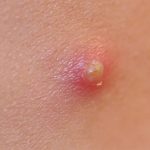 A reaction of tissue to infection that results in a small superficial elevation caused by the collection of pus under the skin.
A reaction of tissue to infection that results in a small superficial elevation caused by the collection of pus under the skin.
Small, inflamed, pus-filled lesions.
Pimple, blister.
A small, circumscribed elevation of the skin containing pus.
Small, raised area of the skin filled with pus or lymph.
Lower opening of the stomach leading into the duodenum. The pylorus is closed most of the time by the pyloric sphincter, a ring of muscles that opens at intervals to allow the flow of chyme into the duodenum.
A small elevation of the skin containing pus.
A muscle which surrounds the pylorus, makes it contract and separates it from the duodenum.
Muscular ring in the stomach separating the stomach from the duodenum; also called pyloric valve.
The thickened circular smooth muscle around the pyloric orifice at the junction of the stomach and duodenum. The sphincter is usually contracted but relaxes at intervals (when gastric pressure exceeds duodenal pressure) to permit acid chyme to enter the duodenum. It then contracts to prevent backup of chyme to the stomach.
At the bottom of the stomach lies a sphincter whose primary function is to regulate the pace at which chyme, a partially digested mass of food, is discharged into the small intestine.
Nestled at the lowermost region of the stomach, a remarkable anatomical feature takes center stage—the pylorus valve. This crucial structure, comprising a broad band of muscular fibers, assumes a pivotal role in regulating the passage of food from the stomach to the small intestine. Positioned at the gateway between these two vital digestive organs, the pylorus valve acts as a formidable gatekeeper, ensuring the precise coordination and controlled release of gastric contents into the intricate realm of the small intestine. The intricate interplay of muscularity and physiological coordination within this remarkable valve underscores the complexity and elegance of our digestive system, painting a vivid portrait of the harmonious mechanisms at work in our bodies.
The valve located at the bottom of the stomach; its role is to regulate the passage of food into the duodenum.
